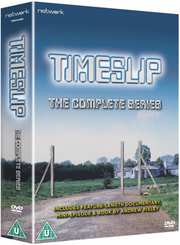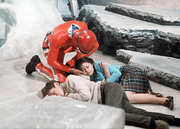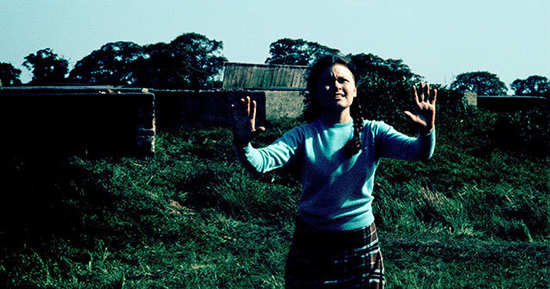Review for Timeslip - The Complete Series
“What is a Time Bubble? You can't see it, of course, but it might help you visualise it to think of a balloon... Supposing some little patch of information – some little patch of history – gets slowed down, and instead of flashing backwards and forwards it floats, gently, as if in a bubble... Supposing you could get into that bubble – that bubble of history – and travel with it. Then you could move forwards and backwards in time at will...”
Introduction by Peter Fairley (Science Correspondent, ITN, 1970) Timeslip: “The Time of the Ice Box”, Series 2 Episode 1
Anyone who loves classic British cult Sci-Fi series will already know about ‘Timeslip’. I watched it for the first time since it aired about a decade ago when I rented the discs via Lovefilm’s home delivery service. I actually regretted not having picked up the set at the time as it went out of print and as a result its price has risen. However, Network’s release of the whole series, as well as some excellent extra features means that we can all get our hands on it again. Having binge-watched the entire 26 episode run over the course of a week or so, I can say that it really stands up and is a well-written, well-executed, well-acted series that is great fun to watch. In short, it's great!
Timeslip was a children’s TV show made at the turn of the decade by ATV for the ITV network and was originally broadcast between 1970 and 1971. Whist it was made principally in colour (on video tape for the most part, other than exterior shots as was the way back then), broadcast union strikes meant that two of the latter episodes were made in black and white. Whilst this sounds less than ideal, and scuppered any chance of distribution in the US, the truth is most kids back in the day would have seen it in black and white in any case. It’s an entirely moot point now of course as only one of the original colour episodes exists at all, serving to show just how great it should have looked.
Two kids, glasses wearing science geek Simon Randall (Spencer Banks) and the older looking tom-boyish Liz Skinner (Cheryl Burfield) discover a "Time Barrier" in the grounds of a disused war-time military base (actually Burnt Farm Army Camp near Goff's Oak, Hertfordshire). A local girl has recently disappeared in the area and it soon becomes apparent why. Feeling their way towards a strange energy field, it seems the children are able to enter different historic periods, usually relating to their own pasts or futures.
It was the creation of ATV script editor Ruth Boswell and her husband, James who initially came up with the idea. Boswell was determined to beat the BBC at their own game with the incredible popularity of Dr.Who at the time. She was also determined not to fall for the usual clichés of space suits and monsters, though, to be fair, the series does include a healthy dose of the former but not until the second story arc. However, there is no doubt that in many regards, its themes and concerns are those of the everyday, albeit couched in science-fiction.
The series ran for four distinct 6 episode seasons which, unusually, form one long interrelated narrative, making it an extraordinarily rewarding series to watch in full. It’s also a pretty complex and sophisticated story to digest, so in some ways, it seems surprising that it was a popular as it was. Indeed, it proved so popular that after the first series, it became a staple comic-strip in Look-In, the comic dedicated to ITV children’s shows of the day.
The series kicked off with a ‘back in time story’, pretty much going against the grain if science-fiction at the time with a serial entitled "The Wrong End of Time" before moving into the future (the heady futuristic landscape of 1990) and which increasingly focused on impending ecological disasters, not dissimilar in theme to the BBC’s ‘Doomwatch’ which was to air just four years later.
It was sci-fi stalwart, New Zealander Bruce Stewart, who was asked to write the scripts and develop the story around the Boswell’s concept. He already had form with the anthology series Out of this World (1962) and Out of the Unknown (1965–71) and he set up about plotting the first series, which then ran to three. When demand for a fourth reared its head half-way through the production run on series three, Stewart had moved on to his next commission was unavailable for the fourth and final series which was penned by Victor Pemberton, previously a script editor for ‘Dr. Who’ and writer of ‘Fury from the Deep’.
The two children ‘stars’ of the show were both relative unknowns at the time of casting. Cheryl Burfield, who played Liz Skinner, was eighteen at the time of her audition – far too old to play a thirteen-year old as originally intended, but the script was re-written to raise her age to 15, just about believable at the time.
No such worries with her co-star Spencer Banks, who played Simon Randall who was actually 15 at the time of filming the first series. Although neither went on to a great deal after the series, Banks went on to star in ‘Tightrope’ (1972) and ‘The Georgian House’ (1976) as a young man with a broken voice – both series currently available from Network.
The real star proper for the show was Dennis Quilley, who played the ever present Commanding Officer Charles Traynor, who was already renowned as leading light at the National Theatre at the time and he’s certainly a commanding presence here. According to the feature-length documentary, contained on the 5th disc of the set, it was Quilley’s authoritative leadership that really set the bar for the cast and he is fondly remembered by all who worked on the show as a result.
SERIAL 1: The Wrong End of Time (DISC 1)
In "The Wrong End of Time", recently orphaned Simon is about to go on a caravan holiday with friends of his parents; father Frank (Derek Benfield), mother Jean (Iris Russell) and daughter Liz. They’ve been staying in a small village, St Oswald, where Frank had served at a research base during WWII. He has no recollection of his time there, as though hi smind has been wiped of all memory, and yet he finds himself drawn there. By ‘coincidence’, another visitor staying at the local hotel, is Charles Traynor, who had served on the base during the war as the Commanding officer. Now abandoned, the military site is a creepy place, emitting weird electronic sounds and odd vibrations.
When Liz and Simon find themselves passing through a time barrier back to the war, they meet both Traynor and Frank, albeit that both were substantially younger. It seems they have happened upon an important research establishment (specialising in radar) just a s group of German’s arrive and take them prisoner.
The children, and especially Liz, seem to have a strong telepathic link to Liz’s mother back in their own time – almost as if she can read what they’re up to and any imminent danger. But the link is decidedly one way so she can have no influence on the children from her side.
Despite being shot by a German officer, Liz seems to be indestructible, confirming Traynor’s theory that the children are never in any real danger when outside their own time.
Eventually, Liz, who is the first to escape, re-enters the time barrier in order to rescue Simon but when they both return though the barrier, it is to some frozen future that they find themselves. Which is a great cliff-hanger to leave things on until the start of Serial 2.
SERIAL 2: The Time of the Ice Box (DISC 2)
So the kids tumble into a frozen 1990 in Antartica where they find themselves in the vicinity of a top-secret research establishment dedicated to the advancement of science. Even more weirdly, it transpires that Liz’s mum works there (all dolled up with a futuristic hair-do and showing no signs of having aged thanks to a longevity drug which they are testing at the lab). She also runs into an older version of herself, an officious, ambitious person with no redeemable traits. The place is run by Morgan C. Devereaux (John Barron – yes, he of ‘I didn’t get where I am today’ fame in Reggie Perrin), a man dedicated to science who is extremely autocratic, insisting that no one deviates from the actions decreed by a computer which he himself programmes. The computer continues to make errors which Devereaux refuses to countenance. It’s Simon who first notices that that Devereaux is starting to black out at moments, freezing like a robot with no power for a few moments at a time. Could this be the cause of more and more mistakes and mishaps in the lab? Eventually the heating fails as a result of computer error and all the staff (as well as the kids) tale an anti-freeze drug to survive long enough for Liz and Simon to go through the time barrier and get help. As they leave, they pass the now frozen body of Devereaux.
SERIAL 3: The Year of the Burn Up (DISC 3)
Back in their own time, Traynor warns Simon and Liz not to try and use the Time Barrier again. But Simon is convinced Traynor has something to hide that he doesn’t want them to discover or change. Heading back through the TimeBarrier they arrive back in 1990 but to an alternate future where England is covered in a thick tropical rainforest (global warming anyone?).
Liz again meets her older self but this time she has become a hippy-like figure who has rejected technology to live with a group of outsiders, embracing nature. Hilariously Simon also meets his future self, Controller 2957, deliciously played by the wonderful David Graham (who I’ve had the immense pleasure of working with on a couple of occasions), best known for his voice work with Gerry Anderson, as Brains and Parker in particular. He’s invoking a ‘master plan’ set out by Traynor in 1970, though he has since abandoned Traynor who, twenty years into the future is still alive and now a foe of Simon’s. Are you following? Indeed, it’s Traynor’s meddling with Simon’s computer that has brought on the global warming. Beth (the older Liz who changed her name) helps Liz and small Simon back through the time barrier…
SERIAL 4: The Day of the Clone (DISC 4) [SPOILER ALERT!]
Despite being penned by a different writer. The final serial does a great job at tying all the ends together into a satisfying chapter. Liz tries to get back to 1990 to help her future self, Beth, but is kidnapped by Traynor. So Simon, now notably older with a lower voice than previously, goes in search of Liz, eventually finding her at ‘R1’, a research station run by Traynor. It’s there that they discover more than just research into human longevity – but into cloning. But when Traynor tries to shut R1 down, fearing what may happen if the cloning succeeds, Devereaux imprisons him and replaces him with a clone. In other words, the Traynor they had known throughout the series.
When Liz and Simon get back through the time barrier to 1970, they find the real Traynor locked in a secret room which is where he’s been since 1965. They then confront the clone version of Traynor at the time barrier at St. Oswalds which seems to drag him through the time barrier, leaving Liz and Simon to go back to Liz’s family.
The feature-length ‘Behind the Barrier’ is the main feature of the set and it provides such an exhaustive overview that it almost makes the remaining extras a little superfluous. Created by the folk behind the official Timeslip website (http://www.timeslip.org.uk) it uses contemporary (well, 2009) interviews with surviving cast and crew to drive the narrative. It traces the history of the series from its inception (the idea, casting, writing) right through each of the seasons to spin-offs like comics and books to re-unions and fan conventions.
Then there are a number of lesser, fan focused features like a sorry looking fan convention from 2007 in a local boozer close to where the barrier sequences were shot, with cast members looking quite awkward until unleashed to walk to the barrier together. It’s pretty much an amateur piece that will really only please the most hardened of fans.
The special edition box set (worth grabbing before it goes as it has ‘collector’s item’ written all over it) ships with a book on the making of the series by TV historian Andrew Pixley. His name alone should convince British archive TV fans of the value of the piece. Sadly I haven't seen it yet but am sure it will be exhaustive, authoritative and fun, in common with his other works.
There are some scripts and production paperwork too (as PDFs) which will delight fans of the series too.
If you like TV from this period then I cannot recommend Timeslip enough. It’s brilliant fun from start to finish and, despite being sourced from less than perfect, black and white video tapes, stands up remarkably well today, some 46 years after its original airing. Brilliant stuff.





































Your Opinions and Comments
Be the first to post a comment!